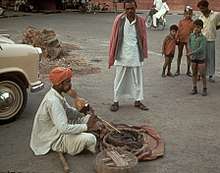Pungi

The pungi (Hindi: पुंगी), also called the been (बीन) and murli, is a wind instrument played by snake charmers on the Indian subcontinent. The instrument consists of a mouth-blown air reservoir made from a gourd, which channels air into two reedpipes. The pungi is played with no pauses, with the player employing circular breathing. The pungi originated in India and is still played by snake charmers in street performances.
History
The pungi was originally developed as an Indian folk music instrument, and is still important for religious purposes and music in India. The pungi was popular in the Badagutittū about fifty years ago. However, prior to this it derived from Indian folk music and was used for religious purposes for snake charming.[1]
Construction

The pungi is traditionally made from a dried bottle gourd. Often, the neck of the gourd is carved for aesthetic reasons. On the other end, two (sometimes one or three) reed or bamboo pipes are connected. These are known as the jivala. One of the pipes has 5 - 9 holes and plays the melody; the other pipe is for drone. The jivala is fitted to the gourd with beeswax, which can be adjusted for pitch modification.[1] The pungi is typically one to two feet in length[2]
Murli
Murli is a typical folk musical instrument.[3] Murli[4][5][6] musical instrument is mostly played by cobra charmers[7] in Sindh Pakistan including Rajasthan.[8] The Murli instrument is made from gourd.[9] It is also mentioned as double-reed instrument.[10] Murli is played by Jogi or Jogis in streets of every city, Thar desert and in whole Sindh yet.[11] Iqbal Jogi and Jai Ram Jogi[12] are famous and well-known expert musicians in playing Murli Instrument in Sindh. Mostly, Murli is continuously played and while playing it, the musician expertly breathes.
Introduction
Murli is a typical musical instrument which is not only played by snake charmers but it is traditional musical instrument played by traditional or folk musicians with musical melodies. It is revealed that the lively instrumental music of Murli is surely meant to put someone in half conscious state, but not just set back a snake in typical bag or case.[13] In fact, Murli is same musical instrument played by Jogis or cobra charmers which needs round mouthful of air for playing. The melody of Murli is high and thin in tone or a continuous low humming sound and almost fast tone for tune or melody.[13]
Construction
Pungi is constructed from a solid cover of coconut by fitting piece of bamboo in it. Pungi is particularly played by snake charmers to involve snakes for dancing mostly in Terai regions, Nepal.[14] While, Murli instrument has two fractions. The first portion is constructed from a dry and swollen gourd which is major sound hollow. The second portion is made from two jointed double reed pipes having holes.[15] The reed portion of Murli has often eight holes but in some areas of Sindh, Pakistan it has an extra hole in right pipe.[15] One of two reed pipes is for playing a hum and second for creating melody.[13]
Usage
Indian musical practices often coincide with religious ideals. An example would be the comprehensive practice of mantra incantation, which can be defined as a succession of syllables (with or without meaning) used to create prayer to a supernatural force or deity. The pungi is believed to be one of the many ways in which one can communicate with the gods through devotional genres.[16]
See also
- Hulusi, a similar Chinese instrument
References
- 1 2 Chhau, Mahakali pyakhan and Yakshagana. Dance and Music in South Asian Drama. Tokyo, Japan: The Japan Foundation 1983.
- ↑ Courtney, David. "PUNGI OR BIN". https://chandrakantha.com. David Courtney. Retrieved 21 November 2017. External link in
|website=(help) - ↑ Avtar, Ram (1983). Musical instruments of India: history and development. Pankaj Publications.
- ↑ "A Seductive Musical Affair – The UrbanWire". The UrbanWire. 2010-06-01. Retrieved 2018-04-07.
- ↑ Manzar, Osama (2016-03-02). "Social media can save folk and oral wisdom". https://www.livemint.com/. Retrieved 2018-04-07. External link in
|work=(help) - ↑ "Fading sounds of tribal rhythms - Times of India". The Times of India. Retrieved 2018-04-07.
- ↑ "Our dying cultural heritage - The Express Tribune". The Express Tribune. 2011-07-09. Retrieved 2018-04-07.
- ↑ "Fusion of styles, cultures & continents at this year's International Folk Festival - The Sunday Guardian Live". The Sunday Guardian Live. 2016-10-22. Retrieved 2018-04-07.
- ↑ Balocu, Nabī Bak̲h̲shu K̲h̲ānu (2012). Musical Instruments of the Lower Indus Valley of Sindh. Culture Department, Government of Sindh.
- ↑ Booth, Gregory D.; Shope, Bradley (2014). More Than Bollywood: Studies in Indian Popular Music. Oxford University Press. ISBN 9780199928835.
- ↑ "Transcendental tradition: Under the spell of Sindhi snake charmers - The Express Tribune". The Express Tribune. 2013-10-14. Retrieved 2018-04-07.
- ↑ "Transcendental tradition: Under the spell of Sindhi snake charmers - The Express Tribune". The Express Tribune. 2013-10-14. Retrieved 2018-04-07.
- 1 2 3 "Asian Sub-continent: India, Pakistan,". www.rootsworld.com. Retrieved 2018-04-08.
- ↑ "Nepali Musical Instruments - We All Nepali". www.weallnepali.com. Retrieved 2018-04-08.
- 1 2 "Instruments of Pakistan | American Institute of Pakistan Studies". pakistanstudies-aips.org. Retrieved 2018-04-08.
- ↑ Ranade, Ashok D. South Asia: The Indian Subcontinent. The Garland Encyclopedia of World Music, 2000 Ed., Volume 5 “Transmission of Nonclassical Traditions”.
